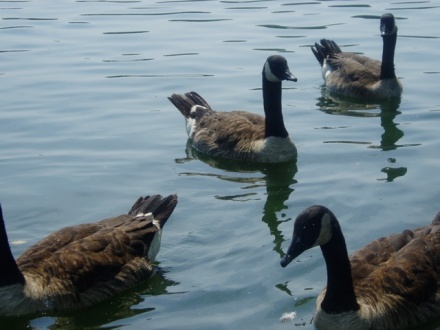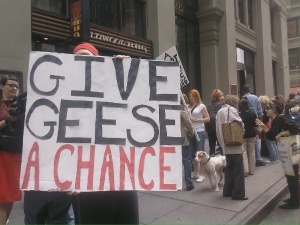After first saying that pesticide spraying would not occur in Prospect Park because of the Celebrate Brooklyn concerts – something that raised a few eyebrows (either something is urgent, or it is not) – the New York City Department of Health backtracked and said pesticide spraying will occur tonight after midnight in the Park.
Prospect Park is a 585 acre park with a 60 acre lake. There are dragonflies and bats — both natural predators of the mosquito, as well as butterflies, ladybugs, bees — all are killed by the pesticide spraying. In addition, people walking through the park tomorrow morning will be breathing in fresh pesticide spray which has known and detrimental health effects. People will be walking their dogs which are close to the ground and they will breathe in and walk through the harmful pyrethroid pesticide, Anvil 10+10.
A few years ago, I flyered Prospect park-goers with literature about the health effects of the pesticides and a woman stopped to tell me, that, after walking through the park the morning after it had been sprayed, she encountered numerous lady bugs on the ground dying.
This is our eco-system — we are charged with protecting it; not killing it.
You have a greater chance of being hit by lightning than getting the West Nile virus. If someone did get West Nile, typically, they would not know it or might experience a slight cold.
The city is also spraying other sections of Brooklyn and Queens. Originally the spraying was to take place Wednesday, August 3rd but was delayed due to rain.
See further information from the No Spray Coalition, an organization I work with —
NEW YORK CITY MUST STOP SPRAYING TOXIC PESTICIDES IMMEDIATELY
The City has announced it will spray dangerous pesticides in crowded residential areas in Brooklyn and Queens on Thursday, August 4th, 2011.
The No Spray Coalition is appalled by Mayor Bloomberg’s and the City’s Department of Health decision to renew the mass-spraying — no legitimate reasons given.
We also condemn the New York City government’s advice to residents and visitors that they personally use insect repellants containing DEET on themselves and their children. DEET is especially dangerous for children and should NEVER be used; it is associated with numerous infant deaths. The City knows this; we negotiated an agreement with the City last year that they wouldn’t recommend DEET.
Furthermore, this year’s spray of choice — Anvil 10+10 — is listed in Local Law 37 (2005 update, see page 1, paragraph 4, discussion of table 2) that states that for piperonyl butoxide and MGK-264 contained as synergists in Anvil 10 + 10, that:
both of these chemicals are classified as possible human carcinogens by the EPA Office of Pesticide Programs. Only 94 products contain pyrethrins without other carcinogen ingredients. Therefore, most products containing pyrethrins continue to be prohibited under LL37 even if the reference to the EPA list was updated.
Local Law 37 prohibits the use of pesticides by NYC in public places if it contains PBO and/or MGK-264. Why are they violating their own law?
The No Spray Coalition is also deeply troubled not only by NYC’s reckless spraying of Anvil 10 + 10 to kill mosquitoes, but for the City’s very short notice — around 24 hours, that’s it!
“After years of litigation to stop this reckless spraying of pesticides which has contributed to skyrocketing increases in cancer and asthma, and now the collapse of bee colonies in the New York area, I am outraged that the Bloomberg Administration is renewing its mindless criminal poisoning of the people and environment of our City,” said Howard Brandstein, coordinator of SOS-FOOD, NY State Against Genetic Engineering, and a plaintiff in a federal lawsuit brought seven years ago by the No Spray Coalition and other organizations against Rudolph Giuliani and the New York City government.
That lawsuit ended in April 2007, when NYC signed a settlement agreement acknowledging, among other stipulations, that pesticides:
– may remain in the environment beyond their intended purpose
– cause adverse health effects
– kill mosquitoes’ natural predators (such as dragonflies)
– increase mosquitoes’ resistance to the sprays, and
– are not presently approved for direct application to waterways.
The Department of Health contravenes that settlement by now stating that there are no significant risks of adverse impact to human health associated with the proper use of this product. “That is simply a lie,” said No Spray Coalition coordinator Mitchel Cohen. In fact, the spraying puts many New York City residents and visitors at grave risk.
“These kind of ignorant and lying politicians and bureaucrats apparently have no problem destroying our health in order to ‘save’ us from the so-called West Nile virus,” Howard Brandstein added. “Clearly, the spraying jeopardizes a thousand times more people than the disease.”
The pesticide the City is spraying — “Anvil 10 + 10” — belongs to a class of adulticides known as pyrethroids, which are endocrine disruptors. They mimic hormones such as estrogen, and may cause breast cancer in women and drastically lower sperm counts in men. Pyrethroids have also been associated with prostate cancer, miscarriages and preterm delivery, asthma, toxicity to many vital organs including the nervous system, liver, kidneys and the gastro-intestinal tract, skin rashes, itching and blisters, and nausea and vomiting.
Anvil contains the cancer-causing chemical piperonyl butoxide, which the Environmental Protection Agency lists as a suspected carcinogen. It also contains Sumithrin — a synthetic toxin, made in the laboratory — as well as benzene-related chemicals (which the label calls “inert ingredients.”) (more…)



















